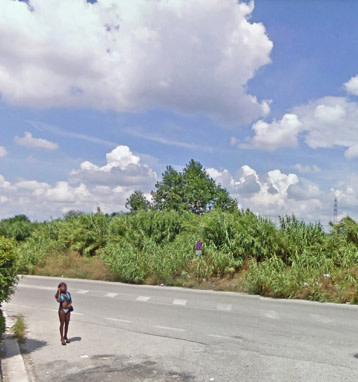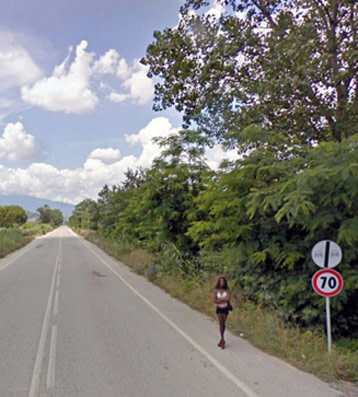Review: Mishka Henner’s “No Man’s Land”

Contrada Vallecupa, Colonnella, Abruzzi, Italy
{% display:image for:post image:0 align:left %}

Contrada Vallecupa, Colonnella, Abruzzi, Italy
Google Street View has raised a number of controversies involving invasion of privacy, mostly involving people—often the wealthy kind—not wanting easily searchable photo documentation of their houses and private property, that in turn incite questions about how much of our physical world we really want publicly accessible online without our knowledge or consent. Photographer and self-titled ‘aggregator’ Mishka Henner has pushed those questions into a whole new world with his exhibition “No Man’s Land” at Blue Sky Gallery.
Henner visited web forums where men describe common sites in Italy and Spain to find prostitutes, and then he scoured the GSV database for the automatic and extensive photographs of those places. What he found were women, mostly alone, sometimes in pairs, standing by the side of the road or sitting in dirty plastic folding chairs along long stretches of empty rural highway or industrial park-style suburbia. Some are on their phone talking or texting; others simply stare at passing traffic. Some are dressed in shorts and shirts; others nothing but bikinis.
Under the strong Mediterranean sun, most of the pictures are blown out, bleak, and occasionally marred by the panoramic glitches of the GSV cameras. Garbage litters the side of the road and shade seems fleeting if nonexistent. Some of the women sit under umbrellas like they’re next to a pool instead of a highway (one wonders how far they carried the umbrella).
But there’s something eerily beautiful about the pixelated images of these women idly occupying blank expanses of space. There’s a patience and even rooted resilience, tinged of course by immense boredom, to their wait. If they were cowboys or farmers in the Wild West, the images would even be romantic.
But, of course, they’re not, and the images become much more sinister when one starts to think about the traffic for which they wait. If they are indeed prostitutes, then their idleness and isolation suddenly become immense vulnerability. If that bush or underpass behind them is their point of transaction, who would hear them scream if their trick turned violent?

Strada Provinciale 1 Bonifica del Tronto, Controguerra, Abruzzi, Italy
In turning GSV into a documentary archive, the exhibition raises a number of questions, the most obvious and troubling of which is: how do we know any of these women are actually prostitutes? Yes, Henner is going by John websites, but that doesn’t mean it can’t just be a woman passing through. And several do appear just to be someone walking to or from the main road on a side path. Some critics called it exploitative to identify women as prostitutes and then profit from them without their consent (a John at least pays—although, of course, Google is the original photographer to capture without compensation) and have even lobbied for Henner’s book to be pulled.
The complaint about compensation seems somewhat moot, given few subjects of documentary style photography are paid for their image. More troubling to me is the implications of identifying, if even implicitly, an individual as a prostitute without any knowledge of who she is beyond her geographic location at that one moment in time and her choice of dress. (I won’t even get into the debate about whether this qualifies as documentary photography or something much lazier, although Henner identifies himself as an “aggregator of sorts, finding the visual means with which to represent a number of cultural and social issues revealed by the technology”).
That said, while many of the women could be en route from point A to B or waiting for a friend or family member, others, particularly the women in bikinis standing by the side of the road or sitting in folding chairs, sure have chosen odd spots to tan if sex solicitation is not their goal.
Whether one accepts the documentary validity of the photo project (and Henner argues back), the most viscerally troubling, and technologically innovative, component for me was the video installation. Henner uses GSV to make what basically amounts to time-lapse videos of driving down these stretches of barren country road or crumbling industrial highway, but as the Google car approaches the woman, Henner starts to shift over to the side cameras and then to the back cameras. The effect for the audience is to inhabit the perspective of a driver who turns his head to look at the woman as he passes and then looks behind him as she recedes into the distance. Sometimes the woman as still, but in some cases, she bends over or turns. Basically, Henner inserts us into the point of view of the John cruising for sex—the only thing giving away the illusion is the occasional shadow of the GSV camera tower on top of the car and the blurring of the women’s faces. If Henner is exploiting the women by turning them into prostitutes, then he is equally exploiting his audience by making us complicit in the trade. Technology is a double-edge sword (or perhaps a two-way street?). And therein is the poignancy of the exhibition.
For more about Portland arts, visit PoMo’s Arts & Entertainment Calendar, stream content with an RSS feed, sign up for our weekly On The Town Newsletter, or follow us on Twitter @PoMoArt!
